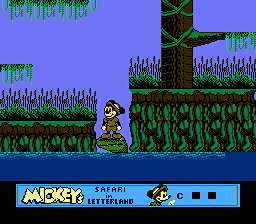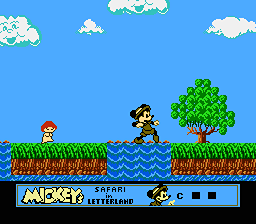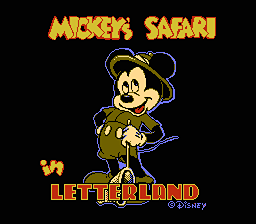
Mickey's Safari in Letterland (1993-)
Developer: Beam Software
Publisher: Hi Tech Expressions
Genre: Educational
Mickey’s Safari in Letterland is an educational platform game developed by Beam Software and published by Hi Tech Expressions for the Nintendo Entertainment System in 1993. Designed for young children, the game aimed to teach players basic literacy skills through interactive gameplay set in colorful, themed environments. It was released exclusively for the NES and was not ported to other platforms. While it does not have a direct prequel, it was later followed by Mickey’s Adventures in Numberland, which used a similar structure to teach basic mathematics. Together, the two titles represent Hi Tech Expressions’ attempt to blend early education with recognizable Disney characters during the later years of the NES.
In Mickey’s Safari in Letterland, players guide Mickey Mouse through six regions inspired by various global environments, including a jungle, desert, ocean, and mountain range. The objective is to collect letters scattered across each stage to spell out the alphabet. The gameplay is simple and forgiving, designed to be accessible for very young audiences, with minimal threats or failure states. Each level concludes with Mickey identifying the collected letters and pronouncing their sounds, reinforcing the educational purpose of the game. The control scheme and visual presentation are both straightforward, allowing children to focus on letter recognition while exploring bright, cartoon-style worlds.
The soundtrack is upbeat and friendly, supporting the game’s educational tone without becoming repetitive or distracting. Each area features distinct background music appropriate to its theme, such as light tropical tunes for jungle levels and relaxed melodies for aquatic stages. The sound effects are clean and clearly defined, signaling jumps, pickups, and interactions with letters in a way that aids comprehension. Beam Software made effective use of the NES’s limited sound capabilities to create an inviting learning environment that aligns with the gentle pacing and positive reinforcement of the gameplay.
Mickey’s Safari in Letterland was promoted primarily to parents and educators as a fun way to introduce early literacy concepts through an interactive medium. Released late in the NES’s lifespan, it stood out as one of the few titles explicitly aimed at preschool-aged children. The game received modest attention upon release, with praise for its accessibility, cheerful presentation, and educational approach, though some critics found it too simple for most players. While it did not spawn a large series, its spiritual successor Mickey’s Adventures in Numberland continued the educational focus, teaching arithmetic in much the same format. Over time, Mickey’s Safari in Letterland has remained a curiosity among NES collectors and an example of how Beam Software used the platform to merge education and entertainment through one of the most recognizable characters in media.
Images from MobyGames
Buy Mickey's Safari in Letterland
Click one of the Ebay or Amazon buttons below to check the latest prices and purchase Mickey's Safari in Letterland for the Nintendo Entertainment System.

Related Searches
Mickey's Safari in Letterland NES Download
Mickey's Safari in Letterland is available to purchase and download from a range of vendors. Always shop around...
Mickey's Safari in Letterland NES Manual
Various repositories around the internet have scanned and archived a range of retro manuals. Search now to.....
Mickey's Safari in Letterland NES Rom
We don't host or link to rom sites for this game. However, there are many sites out there that may be...
Mickey's Safari in Letterland NES Walkthrough
Many sites - particularly YouTube - host a range of walkthrough videos to guide you in your quest to get...
Mickey's Safari in Letterland NES Cheats
There are various sites out there that can offer cheat codes for games. Search now to find all available...
Mickey's Safari in Letterland NES Controls
This information can often be obtained through the user manual. Alternatively there are many sites out there...
Mickey's Safari in Letterland NES Release Date
The initial release date for Mickey's Safari in Letterland is stated as March 1993. Other ports of the game may..
Mickey's Safari in Letterland NES Review
There are many sites out there that have collated and documented historic reviews of this game. Search now...
Mickey's Safari in Letterland Famicom
As a Nintendo Entertainment System release, this game was also likely also available on the Famicom. This....
Mickey's Safari in Letterland NES Speedrun
There is now a community of competitive speedrunners who will try and gain the fastest possible time on their....








